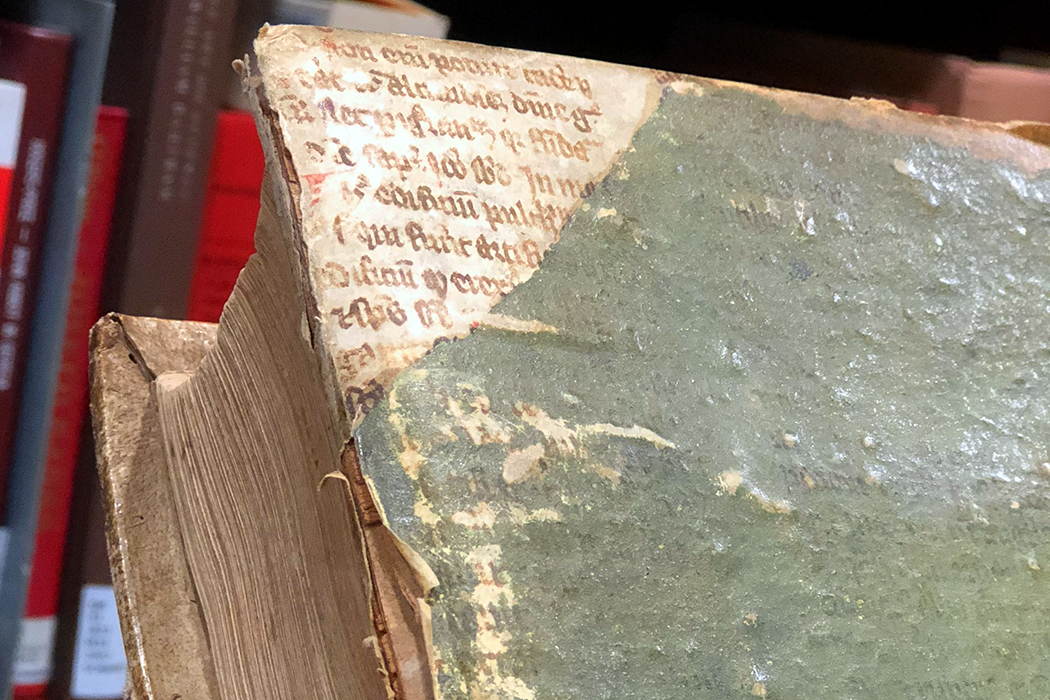The Smithsonian’s Cullman Library holds a gorgeous 1602 edition of Ulisse Aldrovandi’s De animalibus insectis, a pioneering book on insects illustrated with detailed woodcuts. This volume, however, has a deadly secret. Its cover, a collage of recycled medieval vellum and pigskin, is painted green. And that green paint was made with arsenic.
Alexandra K. Alvis, reference librarian, shared this discovery on the Smithsonian Libraries blog, noting that rather “than being a bibliographic murder attempt or a deadly security system, the toxicity of the binding is actually an unintended consequence of an effort to keep this book affordable for 17th century buyers.” And it’s not unique. The University of Southern Denmark’s library recently identified three books from the sixteenth and seventeenth centuries with concentrations of arsenic on their covers. “A plausible explanation for the application — possibly in the 19th century — of Paris green on old books could be to protect them against insects and vermin,” write Research Librarian Jakob Povl Holck and Associate Professor in Physics Kaare Lund Rasmussen in an article for the Conversation.
Throughout the nineteenth century, in fact, having green as your favorite color could be fatal. Arsenic-based greens experienced a surge of popularity in the Victorian age. Particularly popular was Scheele’s Green, named for its eighteenth-century inventor Carl Wilhelm Scheele. It gave enticingly verdant hues to everything from wallpaper to children’s toys. Another arsenic compound was Paris green, a popular color used to create lush green colors on Impressionist canvases.
“From around 1800 manufacturers began to make use of a number of arsenical compounds, particularly as colouring agents,” writes historian P. W. J. Bartrip in The English Historical Review. “Cheap to produce, chemically stable and capable of yielding vivid hues, the most popular of these was Scheele’s Green (sometimes known as emerald green or copper arsenite).” Bartrip adds that it was “found in literally dozens of goods in everyday use,” including books. “Any manufactured item coloured green was as likely as not to have been dyed with arsenic, and in the mid-nineteenth century shades of green were the height of fashion, especially for home furnishings and women’s clothing.”
The noxious nature of these greens was not unknown, as arsenic had long been employed as poison. Indeed, it was purposefully used in some goods in order to ward off infestation. In 1873, Scientific American bravely opened “numerous letters” from readers who included samples of fabrics and wallpapers. Many were revealed to include arsenic, and the publication advised: “Toy books with green covers are always to be suspected, and in fact the only absolutely safe thing to do is to avoid green colors altogether.”
Want more stories like this one?
A consumer activist from Michigan named Robert C. Kedzie deliberately made a poisonous book in order to raise awareness of arsenic in the home. “Since Paris Green was a popular color in widespread use, Kedzie bought eighty rolls of the arsenic-impregnated wallpaper in 1874, bound them into books, and sent copies to one hundred libraries in the state of Michigan,” states historian Jan Jennings in the Winterthur Portfolio. “The volume, Shadows from the Walls of Death, contained eight pages of wallpaper with the deadly pigment.” Rare copies survive, with one at the University of Michigan Library appointed their “most dangerous book.”
While these lethal greens were eventually phased out as pigments, into the mid twentieth century they were used as pesticides, and hazards remained for workers in their factories. “Chronic arsenical poisoning is a condition to which most of the men are exposed; acute pains in the abdomen, and nausea and intense thirst are first noticed,” cites a 1917 Monthly Review of the U.S. Bureau of Labor Statistics. “This is followed later by gastritis, enteritis, jaundice, and diarrhea, followed by constipation. Nails drop off, large ulcers develop, and the skin appears somewhat mummified. In intense cases, death sometimes results.”
Understandably, the Smithsonian’s Cullman Library has its copy “under wraps for the foreseeable future.”







